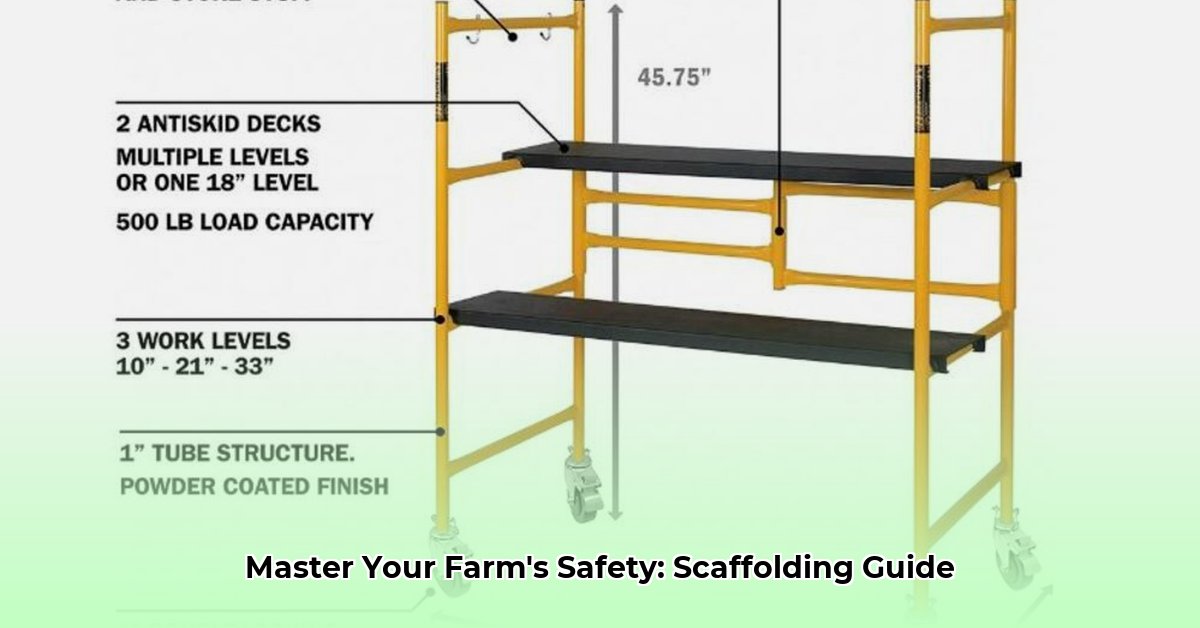
Working at heights on a farm presents significant safety risks. Efficiently maintaining orchards, harvesting crops, or repairing equipment often requires reaching challenging areas. This comprehensive guide details how to safely and effectively utilize scaffolding on your farm, maximizing productivity while minimizing risk. We'll cover scaffolding selection, setup, practical applications, maintenance, and troubleshooting to ensure you benefit from a safer and more efficient operation. For more farm equipment info, check out this resource.
Choosing the Right Scaffolding for Your Farm
Selecting the appropriate scaffolding hinges on your farm's specific needs and the types of tasks you'll undertake. Three main types are commonly used in agricultural settings:
1. Mobile Towers: These lightweight, portable scaffolds are ideal for smaller tasks and limited height access. Their ease of setup and maneuverability makes them perfect for quick jobs like pruning low branches or accessing equipment controls.
2. Frame Scaffolding: Considered a workhorse option, frame scaffolding offers greater stability and a larger working platform. Its versatility makes it appropriate for extensive projects like orchard maintenance or greenhouse work.
3. Rolling Scaffolding: For uneven terrain, rolling scaffolding provides superior mobility. Wheels facilitate easy movement across sloped fields or bumpy ground, enhancing efficiency and safety in challenging environments.
| Scaffold Type | Advantages | Disadvantages | Ideal Applications |
|---|---|---|---|
| Mobile Tower | Easy setup, lightweight, portable, cost-effective | Limited height and weight capacity, less stable | Small tasks, quick access to low-lying areas |
| Frame Scaffolding | Sturdy, adaptable, large working area, good stability | More complex assembly, heavier, requires more space | Large projects, extensive work requiring stability |
| Rolling Scaffolding | Excellent maneuverability, suitable for uneven terrain | Can be more expensive, may require more setup space | Uneven terrain, large areas, moving between locations |
Before purchasing, assess your farm's layout, typical tasks, and height requirements. Determining weight capacity needs is critical to ensure safety. Choosing the right scaffolding ensures efficient and safe operation.
Safety First: Setting Up Your Scaffolding System
Prioritizing safety is paramount. Improper setup is the leading cause of scaffolding accidents. Follow these critical steps:
Level Ground: Ensure a stable, level base. Uneven ground dramatically increases the risk of tipping. Use leveling boards or fill if necessary to create a stable foundation. Don't underestimate this step; it's fundamental to safety.
Manufacturer's Instructions: Adhere strictly to the manufacturer's assembly instructions. Ignoring these instructions compromises safety and may void warranties. If unsure, consult a professional.
Secure Anchoring: Use appropriate tie-downs and bracing to secure the scaffolding. Strong anchoring prevents movement and instability, crucial in windy conditions or on uneven terrain.
Weight Limits: Never exceed the scaffold's weight limit. Overloading is a major cause of collapses. Always work well below the maximum capacity to ensure stability and safety.
Personal Protective Equipment (PPE): Always wear a hard hat, safety harness, and sturdy work boots. Additional PPE such as safety glasses and gloves may be necessary depending on the specific tasks. Never compromise on safety gear. Isn't your safety worth it?
Practical Farm Applications: Maximizing Scaffolding's Potential
Scaffolding significantly improves efficiency and safety across various farm tasks:
Orchard Maintenance: Easily and safely access high branches for pruning, spraying, or harvesting. This reduces strain and the risk of falls.
Greenhouse Work: Maintain and repair hard-to-reach areas within your greenhouse. Scaffolding enhances efficiency and worker safety.
Livestock Management: Safely access high areas in barns or pens for cleaning, inspection, or animal care. It minimizes risk to both the animals and the farmer.
Farm Equipment Repair: Reach and repair difficult-to-access areas on machinery, reducing downtime and improving overall efficiency.
Maintenance and Storage: Extending Scaffolding Lifespan
Regular maintenance is crucial for ensuring safety and maximizing the lifespan of your scaffolding:
Regular Inspections: Inspect your scaffolding before each use, checking for any damage, loose bolts, or worn components. Address issues promptly.
Cleaning: Clean your scaffolding after each use to remove debris and prevent rust or corrosion. A clean scaffold is a safe scaffold.
Proper Storage: Store your scaffolding in a dry, protected area to prevent damage. Storing it off the ground helps prevent moisture damage and extends its usable life.
Troubleshooting Common Scaffolding Issues
Even with careful maintenance, problems may arise. Here’s how to handle common issues:
Wobbling Scaffold: If your scaffolding wobbles, immediately cease use. Check for loose connections, uneven legs, or overloading. Address the problem before resuming work.
Damaged Components: Never use scaffolding with damaged components. Repair or replace damaged parts immediately. Safety must always come first.
Assembly Difficulties: Consult the manufacturer's instructions if struggling with assembly. If problems persist, seek professional assistance.
Investing in and maintaining appropriate scaffolding is a crucial investment in your farm's safety and productivity. Remember, a safe work environment is a productive work environment.